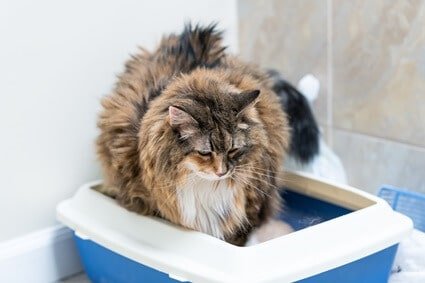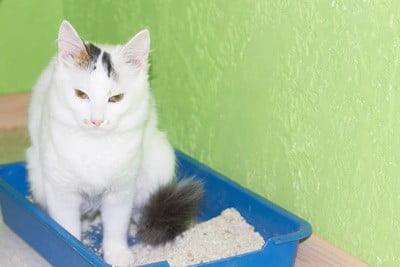Perhaps your senior cat has given up on its training and potties wherever it pleases. Elderly cats often have difficulty with their bathroom habits, so you might have to re-train them or make some adjustments. You’ll have to factor in the older cat’s existing preferences, as well as its old habits.
To litter train an older cat, follow these steps:
- Provide more litter box options
- Litter boxes should be low-walled, as big as your cat in length
- Choose a litter that resembles sand
- Place the litter trays in secluded positions with low traffic
- Put your cat in the litter box 30 minutes before and after mealtime
- Avoid cleaning up the litter right away to maintain the scent
- Keep food and water bowls away from the litter box
Offer your cat gentle, positive reinforcement when it uses the litter. If it makes mistakes, clean it up and return the cat to its box. The learning process may take longer with an older cat.
How To Train an Older Cat to Use a Litter Tray
Here are simple steps to litter train a senior cat:
Get More Litter Boxes
Senior cats should have at least two large litter boxes placed in different areas of the house to ensure that they don’t have to walk far to reach them.
According to Veterinary Sciences, it could be difficulty walking or trouble with incontinence.

Pick The Right Shape And Size
Your litter box must be a size that allows your cat to climb into and out of it comfortably, and it should have low walls. The litter box should be as wide as the cat’s length, including its tail.
Opt for an uncovered box for litter training and stay away from fancy, self-cleaning ones for now. Your senior cat needs a basic litter box to make it easier for it to learn how to use it again.
Get a litter scoop with the box, too, so you can clean it right after your cat has pooped.
Choose Clumping, Dust-Free Litter
The type of litter you buy plays a major role in how quickly your cat gets litter trained. Clumping litters with a fine-grain texture work best.
Also, opt for an unscented type since any strong smells can stress out your elderly cat, which may be more sensitive. This could cause it to form a negative association with the litter box.
Find a Quiet, Secluded Spot
Place the litter boxes in a quiet, low-traffic area where your cat can get some privacy. You can place the litter box behind a cat-safe plant or in a storage space, as long as it’s easily accessible.
Small, contained areas will make the litter box easy to find, so your cat will be more tempted to use it.
Make the Initial Introduction
Your preparations are now complete, and it’s time to move on to the actual litter training.
You should start slowly. If the cat is new to your home, familiarize it with the new box only after it has gotten comfortable with you. Senior cats take their time in adjusting to new places and people.
Once your cat is playful and loving toward you, start introducing it to new objects around the house, like the litter box. Let the cat explore the box with you around, and offer lots of praise and petting as the cat enters it. Your cat forming a positive association with the litter box is the key to training it.
You may need to show it around a few times before your cat gets the hang of the litter box situation. Take it to the litter box half an hour after mealtime and encourage it to dig in the litter. This digging motion naturally triggers urine and bowel movements, leading to cats going to the toilet in the litter box.
Clean it, But Not Immediately
In the first few days, you’ll need to find a balance in how often you clean the litter box. You might be tempted to clean it right away, but cats tend to return to the same spot to use the bathroom.
As such, removing the scent is counter-productive. It is best to leave behind a little bit of poop or a few clumps of the litter, so the cat can smell its way back to the litter box.
Once your cat is properly trained, you can start cleaning out the litter clumps once or twice a day. Ensure that the litter is completely changed out at least once every month, as cats don’t like dirty places.
Keep Food and Water Away
Keep the cat’s food and water away from the litter box.
Your cat has a natural instinct to eat and defecate in different places, so this setup will lead to it refusing to eat and disrupt the litter training.
You can have the litter box in one corner of the room, with the food and water bowls placed on the farthest end possible.
Why Do Older Cats Not Use Their Litter Box?
Sudden changes in your cat’s litter behavior can be a sign of an underlying issue. If your senior cat is litter-trained but has started pooping or peeing outside the litter box, it could be:
- In pain
- Scared
- Experiencing heightened stress
Here are the major reasons why litter-trained cats stop using the litter box all of a sudden:
- Becoming arthritic
- Unable to access the litter box
- Experiencing vision or hearing loss
- Feeling neglected
- Environmental stress
- Poor urine control due to UTIs
How To Prevent Litter Accidents for a Trained Senior Cat
Once you’ve identified why your litter-trained cat has suddenly stopped using the litter box, it’s time to find a solution.
You can resolve the issue by following these steps:
Easy Access to Litter Box
If you live in a multiple-level home, the chances are that the litter box is placed on the ground level while your cat spends most of its time on the upper level.
Cats that have to go up and down numerous steps to get to the litter box usually have more litter accidents, especially older cats with arthritic limbs and weak bladders.
To resolve this, ensure that the cat’s litter box is placed in an area that your cat frequents.
Change Box Design
Older cats develop joint pain and other health problems, so they cannot get into top-entry litter boxes that they could when younger.
So, consider switching to a litter box with lower sides. Be careful not to add too thick a layer of the litter so they don’t have to dig too deeply.
More Litter Boxes
The best way to take care of senior cats is by offering them the utmost convenience.
If you have switched to a low-sided litter box, but the litter incidents haven’t stopped, you can try adding a litter box or two around your house.
According to the Journal of Feline Medicine and Surgery, it’s wise to put them in areas where the cat has had litter incidents before. Have at least one litter box placed on each floor of your home.
New Type of Litter
Even if you’ve used the same litter for years, your cat may have abruptly decided that it doesn’t like it. It may now dislike the texture or scent of the litter in its box.
When trying out new types of litter, pay attention to your cat’s preferences. You should find a brand of unscented litter with a fine texture that’s like sand. Since cats prefer sand as their litter in the wild, this type will be the most likely to satisfy your elderly cat.
Most importantly, give your cat options. Keep the current litter box around and fill a different box with the new litter. Place them both next to each other and observe which box your cat prefers.
This is the litter you should use, and you can start changing out any other boxes accordingly.
Dietary Changes
Kittens, adult cats, and senior cats have very different dietary requirements. Senior cats often require a prescription diet for urinary care, kidney problems, and similar issues.
If your cat isn’t given the best food possible based on their current health, it can lead to litter incidents. These usually result from being unable to hold it in due to poor urinary or bowel health.
When you fix up their food intake, the litter box issues will likely go away on their own. You should also encourage your cat to drink more water as it can prevent UTIs.
Keep Them in a Calm Environment
Senior cats can get stressed out easily. The smallest changes in their environment can trigger nervousness, leading to pooping and peeing incidents.
Therefore, you must ensure that your cat has a quiet, dark corner to itself. Ensure the litter box isn’t placed in a high-traffic area where it’s likely to be disturbed.
Cats can be finicky about litter training, especially if they’re older. With the above steps, you should be able to re-introduce the idea to your senior cat.


We have a rescued outdoor cat that the vet estimated to be 10-11 years old. Prior to our adoption of her she was always outside which she still prefers. She sleeps inside our garage on a heating pad when the temperatures are cool. We have a litter box inside our garage but she has never used it but will pee on the floor during the night. What do you suggest?
For a cat used to toileting in the garden, replicate that inside. Buy a cheap plastic, shallow underbed storage box to use as a big wide litter tray. Position it over the place your cat pees. Fill it with dry garden soil from flower beds and see if your cat will use that. If she does, great, then you can gradually mix into the soil a little unscented cat litter so you can more easily tell where the pee is to remove it. Once she’s litter trained, she can be kept in the house overnight for her safety and comfort as she gets older. As they get older, cats become less and less able to cope with fractious neighbouring cats, the goings on in other gardens, foxes, traffic etc and sensibly come to realise that a warm soft cat bed and litter box inside the house with their humans, is heaven indeed.
I, too, have taken in an abandoned older cat. He also has a heated pad in the garage. I have struggled to get him to use the indoor litter boxes exclusively. He is mostly ok with peeing in the litter boxes, but not exclusively. Pooing is the biggest challenge. I have never seen him poo in the litter box. Always somewhere on my carpet.
Currently, he is back in the garage, because I can’t deal with the poo everyday anymore.
This article and this thread is giving me hope.
I will try again tomorrow.
Thanks.